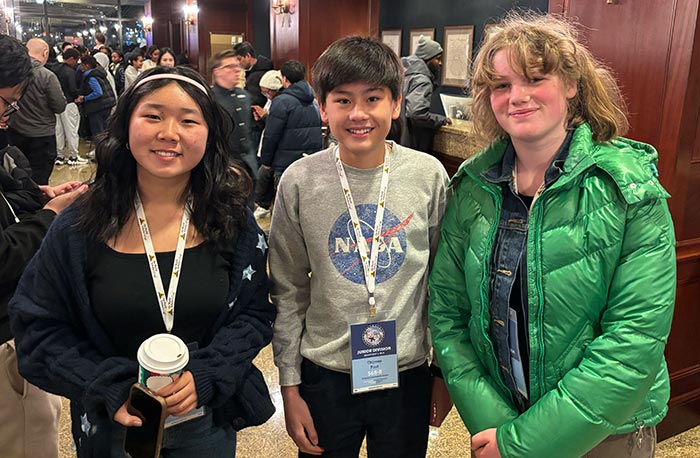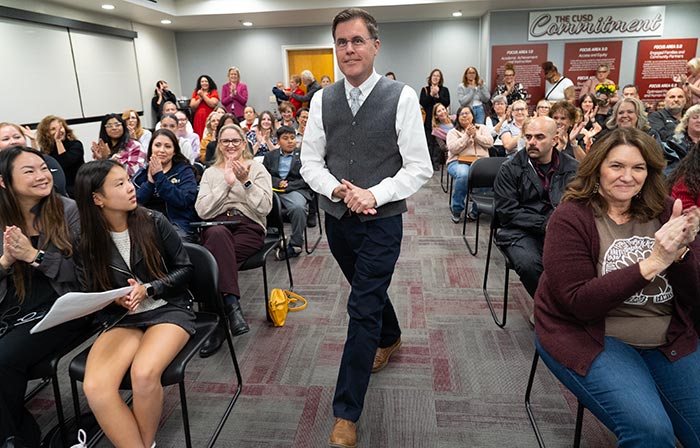Day of the Dead commemorates loved ones lost
Leo Cervantes felt apprehensive Thursday as he stood in front of 31 Sycamore Elementary School peers, expounding on the Day of the Dead.
The sugar skulls and remembrances of the dead, gracing the commemorative altars set up in his great-aunt’s Eleventh Street home, didn’t unnerve him. What worried him was speaking in public.
“This is my first time. I was so scared,” 11-year-old Leo said.
The Day of the Dead, which roughly corresponds to the Catholic holidays of All Saints’ Day and All Souls’ Day, is a Hispanic observance dating back to the days of the Aztecs. It’s said that on the night of November 1, the dead return to visit loved ones and to get a taste of earthly pleasures they once enjoyed.
The students listened respectfully as their classmate explained the photographs, symbolic items and personal effects arranged amid flickering candles, brightly painted skulls and golden marigolds.
“These beans represent the earth, this candle represents fire, the frog represents nighttime and the shell represents the ocean,” he said, pointing to a large, 4-tiered altar.
The ceremonial display helped paint a compelling portrait of real-life characters like Leo’s great-grandfather, Emiliano Cervantes, a stonemason fond of a cold Tecate beer, and his great-grandmother Theresa Cervantes, who was famed for her tamales and had died 3 years previous.
“Oh, they were amazing!” Leo said of her concoctions of cornmeal and perfectly flavored pork.
For most students in Melissa Jackson’s 4th, 5th and 6th grade combination class, the walking field trip to the home of Thomas McGuire and Cynthia Cervantes-McGuire represented their first Dia de los Muertos celebration. The holiday comes fast on the heels of Halloween and shares the same preoccupation with ghosts, without the fright factor.
“It’s not gross or scary. It’s really about celebrating the lives that were—the people who were with us,” Leo’s Aunt Cynthia explained while the students examined the tableaux set up in her living room.
As Leo’s aunt, Yvonne Cervantes-Coleman, shared with the class, the holiday is still a very vital one for many people in North and South America. She recalled a visit she made years ago during the Day of the Dead to the town of Tzintzuntzan in the Mexican state of Michoacan. Members of the community flocked to the cemetery to clean and groom the graves of their departed loved ones, then returned the evening of November 1 for a picnic, enjoyed to the accompaniment of live music.
Colorful memories
Mexican music was playing softly in the background as Leo continued describing the altars in the Cervantes family living room. He became choked up for a moment while describing the significance of the items on the altar dedicated to Charles Cervantes, better known as Uncle Chuck.
Creating Mr. Cervantes’ highly personalized tribute is part of the family’s grieving process, which still feels a little raw. Unlike the other individuals honored by the Cervanteses, who had died in old age after a period of declining health, Uncle Chuck died unexpectedly last December when he was hit by a car.
Leo composed himself and the mood lightened as he and his great-aunt shared stories about the offerings on his altar. Color and vitality were the order of the day on this altar, which included a 45 record of the 1962 hit “Duke of Earl,” a pair of crayon-bright sneakers, a replica of Chuck’s pink Chevy Impala with black flames, a figure of a Trojan horse representing his USC boostership and a can of Diet Coke.
As they prepare for their first Christmas without Uncle Chuck there to help make holiday tamales, they take comfort in the warm display. During the several days the altars are on view, Ms. Cervantes-McGuire and her husband like to partake of an evening glass of wine amid the candlelit altars. Sometimes, family and friends join them.
The creation and sharing of Day of the Dead altars is a tradition that is now 19 years strong among the Cervantes family. This is the first time, however, they have welcomed a score of children into their home to commemorate Day of the Dead.
After the talk, the students were invited to enjoy refreshments on the lawn. The kids helped themselves to plates of pan dulce and sliced fruit and cups of rich Mexican hot chocolate ladled out by Leo’s grandmother, Rebecca Cervantes.
Some kids settled down for a mini-picnic on blankets spread on the lawn while one clique of boys climbed into a tree house-style play structure for their repast.
It was a great conclusion to 2 days of fun, said 11-year-old Wyatt Hill. The day before, Wyatt shared, he and a few friends dressed up in ghillie suits—extreme military camouflage outfits that make the wearer look like a bush—and went trick-or-treating, then enjoyed a party.
Katie Murakoshi enjoyed learning more about Day of the Dead. She first heard about the holiday in her afterschool art class, where she made a rendering of a pair of skeleton trick-or-treaters. Aleks Watkins, 9, has the same art teacher. She drew a pair of skeleton piano players, “but they turned out kind of fat.”
With this year’s exposure, Aleks has come to appreciate the way that Day of the Dead celebrates the dead without morbidity.
“Day of the Dead skulls are more happy than Halloween decorations, because they’re celebrating, not trying to scare people,” she said.
When the students returned to class, they set to work making thank-you cards for the family willing to welcome so many schoolchildren to share in a meaningful tradition.
“It was wonderful,” Ms. Jackson said. “It was really great to see Leo be so open and sharing with his emotions.”
—Sarah Torribio
storribio@claremont-courier.com










0 Comments